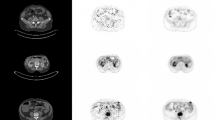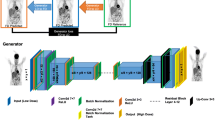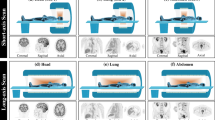Abstract
Purpose
To generate diagnostic 18F-FDG PET images of pediatric cancer patients from ultra-low-dose 18F-FDG PET input images, using a novel artificial intelligence (AI) algorithm.
Methods
We used whole-body 18F-FDG-PET/MRI scans of 33 children and young adults with lymphoma (3–30 years) to develop a convolutional neural network (CNN), which combines inputs from simulated 6.25% ultra-low-dose 18F-FDG PET scans and simultaneously acquired MRI scans to produce a standard-dose 18F-FDG PET scan. The image quality of ultra-low-dose PET scans, AI-augmented PET scans, and clinical standard PET scans was evaluated by traditional metrics in computer vision and by expert radiologists and nuclear medicine physicians, using Wilcoxon signed-rank tests and weighted kappa statistics.
Results
The peak signal-to-noise ratio and structural similarity index were significantly higher, and the normalized root-mean-square error was significantly lower on the AI-reconstructed PET images compared to simulated 6.25% dose images (p < 0.001). Compared to the ground-truth standard-dose PET, SUVmax values of tumors and reference tissues were significantly higher on the simulated 6.25% ultra-low-dose PET scans as a result of image noise. After the CNN augmentation, the SUVmax values were recovered to values similar to the standard-dose PET. Quantitative measures of the readers’ diagnostic confidence demonstrated significantly higher agreement between standard clinical scans and AI-reconstructed PET scans (kappa = 0.942) than 6.25% dose scans (kappa = 0.650).
Conclusions
Our CNN model could generate simulated clinical standard 18F-FDG PET images from ultra-low-dose inputs, while maintaining clinically relevant information in terms of diagnostic accuracy and quantitative SUV measurements.



Similar content being viewed by others
Data availability
Data of this project will be made available.
References
Baum SH, Fruhwald M, Rahbar K, Wessling J, Schober O, Weckesser M. Contribution of PET/CT to prediction of outcome in children and young adults with rhabdomyosarcoma. J Nucl Med. 2011;52:1535–40. https://doi.org/10.2967/jnumed.110.082511.
Cheng G, Chen W, Chamroonrat W, Torigian DA, Zhuang H, Alavi A. Biopsy versus FDG PET/CT in the initial evaluation of bone marrow involvement in pediatric lymphoma patients. Eur J Nucl Med Mol Imaging. 2011;38:1469–76. https://doi.org/10.1007/s00259-011-1815-z.
Kleis M, Daldrup-Link H, Matthay K, Goldsby R, Lu Y, Schuster T, et al. Diagnostic value of PET/CT for the staging and restaging of pediatric tumors. Eur J Nucl Med Mol Imaging. 2009;36:23–36. https://doi.org/10.1007/s00259-008-0911-1.
Huang B, Law MW, Khong PL. Whole-body PET/CT scanning: estimation of radiation dose and cancer risk. Radiology. 2009;251:166–74. https://doi.org/10.1148/radiol.2511081300.
Brenner DJ, Hall EJ. Computed tomography--an increasing source of radiation exposure. N Engl J Med. 2007;357:2277–84. https://doi.org/10.1056/NEJMra072149.
Meulepas JM, Ronckers CM, Smets A, Nievelstein RAJ, Gradowska P, Lee C, et al. Radiation exposure from pediatric CT scans and subsequent cancer risk in the Netherlands. J Natl Cancer Inst. 2018. https://doi.org/10.1093/jnci/djy104.
Pearce MS, Salotti JA, Little MP, McHugh K, Lee C, Kim KP, et al. Radiation exposure from CT scans in childhood and subsequent risk of leukaemia and brain tumours: a retrospective cohort study. Lancet. 2012;380:499–505. https://doi.org/10.1016/S0140-6736(12)60815-0.
Mathews JD, Forsythe AV, Brady Z, Butler MW, Goergen SK, Byrnes GB, et al. Cancer risk in 680,000 people exposed to computed tomography scans in childhood or adolescence: data linkage study of 11 million Australians. Bmj. 2013;346:f2360. https://doi.org/10.1136/bmj.f2360.
Brenner DJ, Doll R, Goodhead DT, Hall EJ, Land CE, Little JB, et al. Cancer risks attributable to low doses of ionizing radiation: assessing what we really know. Proc Natl Acad Sci U S A. 2003;100:13761–6. https://doi.org/10.1073/pnas.2235592100.
Klenk C, Gawande R, Uslu L, Khurana A, Qiu D, Quon A, et al. Ionising radiation-free whole-body MRI versus (18)F-fluorodeoxyglucose PET/CT scans for children and young adults with cancer: a prospective, non-randomised, single-centre study. Lancet Oncol. 2014;15:275–85. https://doi.org/10.1016/S1470-2045(14)70021-X.
Robbins E. Radiation risks from imaging studies in children with cancer. Pediatr Blood Cancer. 2008;51:453–7. https://doi.org/10.1002/pbc.21599.
Chawla SC, Federman N, Zhang D, Nagata K, Nuthakki S, McNitt-Gray M, et al. Estimated cumulative radiation dose from PET/CT in children with malignancies: a 5-year retrospective review. Pediatr Radiol. 2010;40:681–6. https://doi.org/10.1007/s00247-009-1434-z.
Applegate KE, Frush DP. Image gently: a decade of international collaborations to promote appropriate imaging for children. J Am Coll Radiol. 2017;14:956–7. https://doi.org/10.1016/j.jacr.2017.04.039.
Muehe AM, Theruvath AJ, Lai L, Aghighi M, Quon A, Holdsworth SJ, et al. How to provide gadolinium-free PET/MR cancer staging of children and young adults in less than 1 h: the Stanford approach. Mol Imaging Biol. 2018;20:324–35. https://doi.org/10.1007/s11307-017-1105-7.
Theruvath AJ, Siedek F, Muehe AM, Garcia-Diaz J, Kirchner J, Martin O, et al. Therapy response assessment of pediatric tumors with whole-body diffusion-weighted MRI and FDG PET/MRI. Radiology. 2020;192508. https://doi.org/10.1148/radiol.2020192508.
Karakatsanis NA, Fokou E, Tsoumpas C. Dosage optimization in positron emission tomography: state-of-the-art methods and future prospects. Am J Nucl Med Mol Imaging. 2015;5:527–47.
Kim SM, Alessio AM, De Man B, Asma E, Kinahan PE. Direct reconstruction of CT-based attenuation correction images for PET with cluster-based penalties. IEEE Nucl Sci Symp Conf Rec (1997). 2013;2013. https://doi.org/10.1109/NSSMIC.2013.6829245.
Dong X, Wang T, Lei Y, Higgins K, Liu T, Curran WJ, et al. Synthetic CT generation from non-attenuation corrected PET images for whole-body PET imaging. Phys Med Biol. 2019;64:215016. https://doi.org/10.1088/1361-6560/ab4eb7.
Kang J, Gao Y, Shi F, Lalush DS, Lin W, Shen D. Prediction of standard-dose brain PET image by using MRI and low-dose brain [18F]FDG PET images. Med Phys. 2015;42:5301–9. https://doi.org/10.1118/1.4928400.
Wang Y, Zhang P, An L, Ma G, Kang J, Shi F, et al. Predicting standard-dose PET image from low-dose PET and multimodal MR images using mapping-based sparse representation. Phys Med Biol. 2016;61:791–812. https://doi.org/10.1088/0031-9155/61/2/791.
Cui J, Gong K, Guo N, Wu C, Meng X, Kim K, et al. PET image denoising using unsupervised deep learning. Eur J Nucl Med Mol Imaging. 2019;46:2780–9. https://doi.org/10.1007/s00259-019-04468-4.
Xiang L, Qiao Y, Nie D, An L, Wang Q, Shen D. Deep auto-context convolutional neural networks for standard-dose PET image estimation from low-dose PET/MRI. Neurocomputing. 2017;267:406–16. https://doi.org/10.1016/j.neucom.2017.06.048.
Ouyang J, Chen KT, Gong E, Pauly J, Zaharchuk G. Ultra-low-dose PET reconstruction using generative adversarial network with feature matching and task-specific perceptual loss. Med Phys. 2019;46:3555–64. https://doi.org/10.1002/mp.13626.
Sekine T, Delso G, Zeimpekis KG, de Galiza Barbosa F, Ter Voert E, Huellner M, et al. Reduction of (18)F-FDG dose in clinical PET/MR imaging by using silicon photomultiplier detectors. Radiology. 2018;286:249–59. https://doi.org/10.1148/radiol.2017162305.
Lim B, Son S, Kim H, Nah S, Mu Lee K. Enhanced deep residual networks for single image super-resolution. Proc IEEE Conf Comput Vis Pattern Recognit. 2017;136–44.
Banerjee I, Crawley A, Bhethanabotla M, Daldrup-Link HE, Rubin DL. Transfer learning on fused multiparametric MR images for classifying histopathological subtypes of rhabdomyosarcoma. Comput Med Imaging Graph. 2018;65:167–75. https://doi.org/10.1016/j.compmedimag.2017.05.002.
Zaharchuk G. Next generation research applications for hybrid PET/MR and PET/CT imaging using deep learning. Eur J Nucl Med Mol Imaging. 2019;46:2700–7. https://doi.org/10.1007/s00259-019-04374-9.
Wang Y, Yu B, Wang L, Zu C, Lalush DS, Lin W, et al. 3D conditional generative adversarial networks for high-quality PET image estimation at low dose. Neuroimage. 2018;174:550–62. https://doi.org/10.1016/j.neuroimage.2018.03.045.
Wang Y, Zhou L, Yu B, Wang L, Zu C, Lalush DS, et al. 3D auto-context-based locality adaptive multi-modality GANs for PET synthesis. IEEE Trans Med Imaging. 2019;38:1328–39. https://doi.org/10.1109/TMI.2018.2884053.
Sanaat A, Arabi H, Mainta I, Garibotto V, Zaidi H. Projection space implementation of deep learning-guided low-dose brain PET imaging improves performance over implementation in image space. J Nucl Med. 2020;61:1388–96. https://doi.org/10.2967/jnumed.119.239327.
Xu J, Gong E, Pauly JM, Zaharchuk G. 200x low-dose PET reconstruction using deep learning. Computer Vision and Pattern Recognition. Cornell University Library. 2018;arXiv:1712.04119.
Chen KT, Gong E, de Carvalho Macruz FB, Xu J, Boumis A, Khalighi M, et al. Ultra-low-dose (18)F-florbetaben amyloid PET imaging using deep learning with multi-contrast MRI inputs. Radiology. 2019;290:649–56. https://doi.org/10.1148/radiol.2018180940.
Kaplan S, Zhu YM. Full-dose PET image estimation from low-dose PET image using deep learning: a pilot study. J Digit Imaging. 2019;32:773–8. https://doi.org/10.1007/s10278-018-0150-3.
Whiteley W, Luk WK, Gregor J. DirectPET: full-size neural network PET reconstruction from sinogram data. J Med Imaging (Bellingham). 2020;7:032503. https://doi.org/10.1117/1.JMI.7.3.032503.
Code availability
Code details will be made available.
Funding
This study was supported by a grant from the Eunice Kennedy Shriver National Institute of Child Health and Human Development (NICHD, R01 HD081123A) and the Andrew McDonough B+ Foundation. Statistical analysis for this work was also partially supported by the Biostatistics Shared Resource, which is funded by the Cancer Center Support Grant, P30CA124435.
Author information
Authors and Affiliations
Contributions
Guarantors of integrity of entire study: Yan-Ran (Joyce) Wang, Daniel Rubin, Heike E. Daldrup-Link
Study concepts/study design: Yan-Ran (Joyce) Wang, Rong Lu, Daniel Rubin, Heike E. Daldrup-Link
Clinical studies: Lucia Baratto, K Elizabeth Hawk, Allison Pribnow, Avnesh S Thakor, Ashok J Theruvath, Sergios Gatidis, Jordi Garcia-Diaz, Heike E. Daldrup-Link
Data acquisition: Yan-Ran (Joyce) Wang, Lucia Baratto, K Elizabeth Hawk, Ashok J Theruvath, Sergios Gatidis, Jordi Garcia-Diaz, Heike E. Daldrup-Link
Data analysis/interpretation: all authors
Literature research: Yan-Ran (Joyce) Wang, Lucia Baratto, Ashok J Theruvath, Jordi Garcia-Diaz
Statistical analysis: Rong Lu, Santosh E Gummidipundi
Manuscript drafting or manuscript revision for important intellectual content: all authors
Approval of final version of submitted manuscript: all authors
Agrees to ensure any questions related to the work are appropriately resolved: Daniel Rubin, Heike E. Daldrup-Link
Corresponding authors
Ethics declarations
Conflict of interest
The authors declare no conflict of interest.
Ethics approval and consent to participate
Research PET/MR imaging studies have been approved by the Institutional Review Board at Stanford University and the University of Tübingen. All patients provided written informed consent to participate in a research PET/MR study and the results of this research will be published.
Pertinent findings
Using a cohort study of 23 clinical whole-body 18F-FDG PET/MRI subjects, we demonstrated that the AI-reconstructed ultra-low-dose 18F-FDG PET images resemble high similarity with standard-dose 18F-FDG PET images, based on both quantitative and qualitative clinical evaluations. The proposed PET reconstruction model also generalizes in an independent cohort study of 11 clinical whole-body 18F-FDG PET/MRI subjects.
Implications for patient care
We anticipate that our proposed model will enable a new generation of imaging exams for children that can be widely applied to interrogate health and disease without the risk of secondary cancer development later in life.
Additional information
Publisher’s note
Springer Nature remains neutral with regard to jurisdictional claims in published maps and institutional affiliations.
Yan-Ran (Joyce) Wang and Lucia Baratto are co-first authors
This article is part of the Topical Collection on Advanced Image Analyses (Radiomics and Artificial Intelligence)
Key points
QUESTIONCan artificial intelligence augment whole-body PET scans with minimal radiation exposure to the quality of standard-dose PET?
Supplementary information
ESM 1
(DOCX 1373 kb).
Rights and permissions
About this article
Cite this article
Wang, YR.(., Baratto, L., Hawk, K.E. et al. Artificial intelligence enables whole-body positron emission tomography scans with minimal radiation exposure. Eur J Nucl Med Mol Imaging 48, 2771–2781 (2021). https://doi.org/10.1007/s00259-021-05197-3
Received:
Accepted:
Published:
Issue Date:
DOI: https://doi.org/10.1007/s00259-021-05197-3




